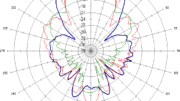Believe it or not, I get asked this question a lot. I mean, it just makes sense, right? It makes you wonder why there are any amplifiers at all with high noise figures. Why would you want anything to add more noise when that could possibly be avoided?
First, a bit of quick education
When you’re talking about digital signals like over-the-air TV, satellite or cellular, it doesn’t matter how much signal you have as long as it’s enough. It’s like, if your friend is talking to you, it doesn’t matter how loud he or she speaks, as long as you can understand what’s being said. If you’re in a noisy room you’ll have to talk louder, of course, and most people don’t have sophisticated signal-processing equipment to filter out the noise in the room. This same thinking applies to digital signals.
Also, every thing, every physical thing, between you and the signal will add noise and lower the signal level. Every connector, every splice, every device will make the signal level lower and make the noise level higher. Add enough things and the noise will overpower the signal. Without fancy equipment, that signal is lost forever.
So, your goal when you’re working with signals on a cable is to keep the loss to a minimum and keep the noise to a minimum. It’s simple as that.
How amplification works
In a lot of cases, when your signal level gets low, you can add an amplifier to boost it up. But adding that amplifier also adds noise, 100% of the time. There are very low-noise amplifiers that add as little noise as possible, and there are others that add quite a bit of noise, up to 6-7dB. Why would anyone use a noisy amplifier like that?
Before answering, I should mention that different manufacturers report noise differently. Most will report “typical” noise, which can mean a lot of things. It can mean that the entire spectrum was tested and most of it didn’t have a lot of noise. That doesn’t mean the part of the spectrum you care about doesn’t have a lot of noise. Other manufacturers will report a minimum number or a specific frequency, ignoring the other frequencies you need. To make matters worse, a lot of antenna makers test their own stuff and report it. Without a special test rig, you’ll just have to take their word for it.
It comes down to the same thing I say a lot:
…all amps aren’t designed for the same use. Certainly you don’t want to add noise when you don’t have to, but the important thing is that if you are going to add noise, you need to do it at the right time.
When a signal comes over the air, it’s very weak. In the case of satellite TV, it’s so incredibly weak that you can’t even put it over a wire before you amply it. If you’re going to amplify a signal so that it’s strong enough to travel from the antenna over a long cable, you need the lowest noise amplifier possible. In fact, satellite dishes have a super-low-noise amp built in.
On the other hand, if the signal is already nice and strong, say for example if you have already amplified it or if it was strong enough to begin with, then you may be able to “afford” a little noise if you’re amplifying it to compensate for the loss due to splitting the signal. When you’re amplifying a signal so you can distribute it, you can add some noise as long as you’re adding enough signal to compensate.
Here’s some math to prove it
If you’re splitting a signal 8 ways, you’re probably losing about 14dB. Just splitting the signal automatically means a loss of 12dB because 12dB = 1/8th. The other 2dB are just from the connectors and electronics and such.
You can compensate for this with a 25dB amp with a 7dB noise figure. In other words, the amp adds 25dB of signal but also adds 7dB of noise. Take 7 from 25, because it’s really the difference between signal and noise that’s important. You have 19dB, and you lost 14dB, so you still have 5dB more than you started with, even though there’s more noise.
Why would you choose a noisy amp rather than one that adds barely any noise? Cost and durability are considerations, and sometimes it makes more sense to choose that noisy amp because you can afford to add a little noise in the situation you’re in. Remember, it’s not how much signal you have, it’s how much more signal than noise. So, you can add more noise if you can also add more signal. Eventually that breaks down, after enough noisy amplifiers, the signal can’t get any stronger and you lose it. But if you’re talking about one amplifier in a home, sometimes a little noise isn’t going to hurt you.
Get the amplifier you need from Solid Signal
SolidSignal.com has a great selection of amplifiers for every need. Shop our great selection now! If you need help choosing the right amplifier, call us at 888-233-7563 during East Coast business hours. We’re here to help.





